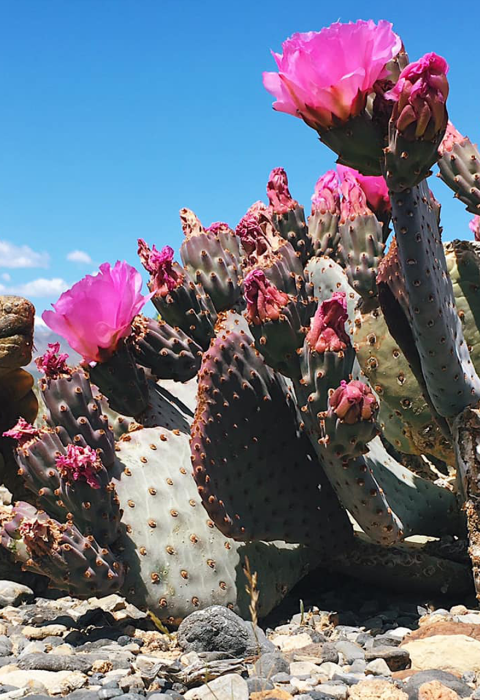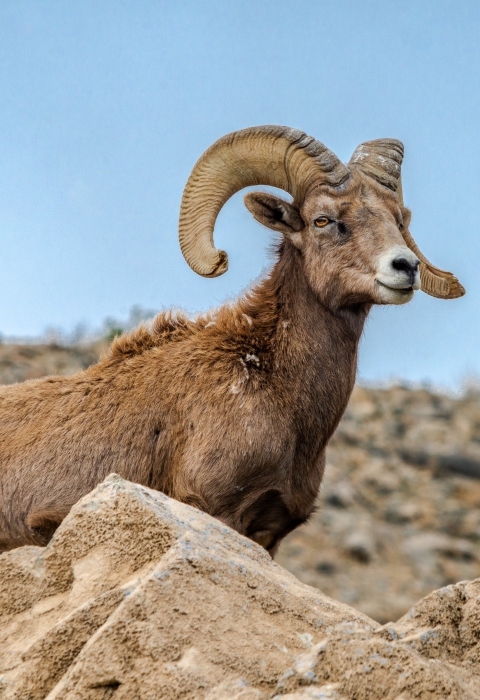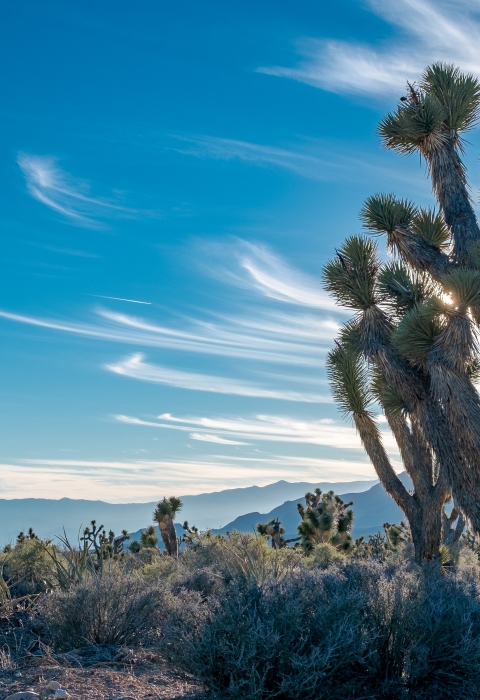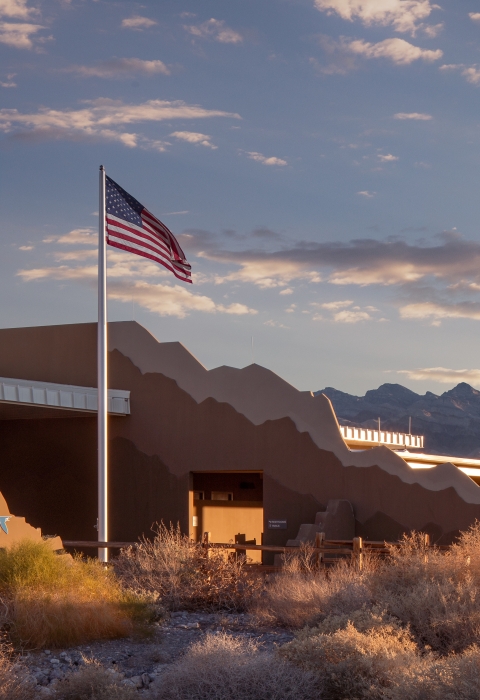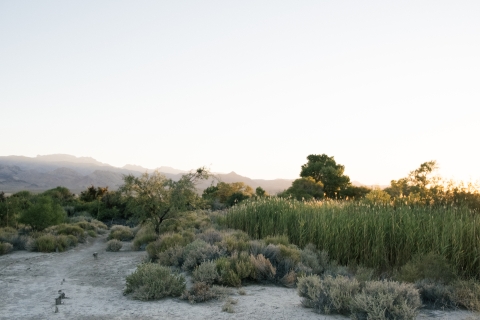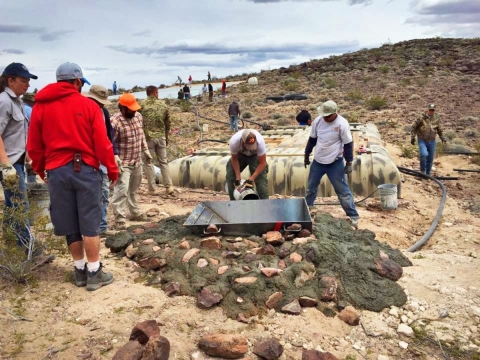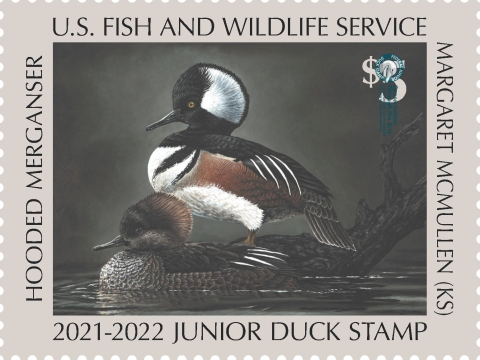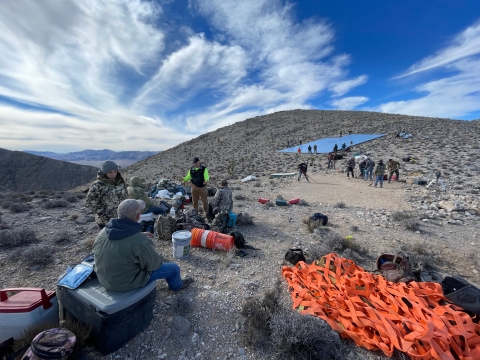What We Do
The National Wildlife Refuge System is a series of lands and waters owned and managed by the U.S. Fish and Wildlife Service. Wildlife conservation is at the heart of the refuge system. It drives everything we do from the purpose a refuge is established, to the recreational activities offered there, to the resource management tools we use. Selecting the right tools helps us ensure the survival of local plants and animals and helps fulfill the purpose of the refuge.
At Corn Creek, active habitat restoration is taking place. Refuge staff works hard to control non-native species and noxious weeds by utilizing an integrated vegetation management approach and planting native species that have been displaced.
For desert bighorn sheep, the animal the refuge was established to protect, the aridity of the desert can be the most challenging aspect of their lives. To increase sheep populations, springs have been improved and water catchments constructed to provide valuable water to sheep and other wildlife. These actions provide water during times of severe water scarcity and increase water availability across the refuge, helping support bighorn populations, decrease competition for water and forage, and reduce vulnerability to predators and disease.
Management and Conservation
Refuge Planning
National Wildlife Refuge planning sets the broad vision for refuge management and the goals, objectives, strategies, and actions required to achieve it. Planning ensures that each refuge meets its individual purposes, contributes to the Refuge System’s mission and priorities, is consistent with other applicable laws and policies, and enhances conservation benefits beyond refuge boundaries.
Refuges use a wide range of land management tools based on the best science available. Some refuges use prescribed fires to mimic natural fires that would have cleared old vegetation from the land helping native plants regenerate and local wildlife to thrive. Other refuges contain Wilderness areas where land is largely managed in passively. The management tools used are aimed at ensuring a balanced conservation approach where both wildlife and people will benefit. At this field station our conservation toolbox includes:
Comprehensive Conservation Plan (CCP)
Comprehensive Conservation Plans (CCPs) are the primary planning documents for National Wildlife Refuges. As outlined in the National Wildlife Refuge System Administration Act, as amended, the U.S. Fish and Wildlife Service (Service) is required to develop CCPs that guide refuge management for the next 15 years. CCPs articulate the Service’s contributions to meeting refuge purposes and the National Wildlife Refuge System mission. CCPs serve as a bridge between broad, landscape-level plans developed by other agencies and stakeholders and the more detailed step-downs that stem from Refuge CCPs.
The 2009 Final Comprehensive Conservation Plan for Desert, Ash Meadows, Moapa Valley, and Pahranagat National Wildlife Refuges can be found here: https://ecos.fws.gov/ServCat/Reference/Profile/7305
For Desert NWR, there are five goals outlined in the CCP:
- Bighorn Sheep: Maintain and, where necessary, restore healthy population levels of bighorn sheep on Desert NWR within each of the six major mountain ranges.
- Wildlife Diversity: Maintain the existing natural diversity of native wildlife and plants, including special-status species, at Desert NWR.
- Specially-designated Areas: Manage specially designated areas such that they augment the purposes of the Desert NWR.
- Visitor Services: Provide visitors with opportunities to understand, appreciate, and enjoy the fragile Mojave/Great Basin Desert ecosystem.
- Cultural Resources: Manage cultural resources for their educational, scientific, and traditional cultural values for the benefit of present and future generations of refuge users, communities, and culturally affiliated tribes.
Step-down Plans
CCP step-down plans guide refuge-level programs for: (1) conserving natural resources (e.g., fish, wildlife, plants, and the ecosystems they depend on for habitat); (2) stewarding other special values of the refuge (e.g., cultural or archeological resources, wilderness, wild and scenic rivers, etc.); and (3) engaging visitors and the community in conservation, including providing opportunities for wildlife-dependent recreation. Like CCPs, step-down plans contribute to the implementation of relevant landscape plans by developing SMART (Specific, Measurable, Achievable, Relevant, and Time-bound) objectives, strategies, implementation schedules, and decision support tools to fulfill refuge visions and goals. This ensures that refuges are managed in a landscape context and that conservation benefits extend beyond refuge boundaries.
Sheep Management Plan
The Sheep Management Plan (SMP) is a step-down management plan derived from the Comprehensive Conservation Plan (CCP.) Its purpose is to guide desert bighorn sheep management to maintain the integrity of the population within the Refuge. The goals, objectives and strategies for managing desert bighorn sheep and its’ habitat are described in the SMP. Further details on partnerships and outreach opportunities are described in the SMP as well.
Desert NWR is one of four refuges in the Desert National Wildlife Refuge Complex. The Refuge was established in 1936 primarily to preserve desert bighorn sheep and their habitat. The Refuge is managed by USFWS, with a portion co-managed with Nellis Air Force Base (Nellis AFB). In support of desert bighorn sheep conservation, USFWS and Nellis AFB work in close collaboration with the U.S. Geological Survey (USGS) and the Nevada Department of Wildlife (NDOW).
The staff of Desert NWR recognized the need to address the long term comprehensive management of desert bighorn sheep. This species management plan (SMP) addresses this need and entails the refinement of desert bighorn sheep conservation goals and objectives as well as analysis of critical threats, strategies to address threats, and indicators to measure conservation progress. The SMP is a step down plan from the “Desert National Wildlife Refuge Complex Comprehensive Conservation Plan,” which was finalized in 2009.1
Implementation of the SMP will be coordinated by USFWS, in partnership with Nellis AFB, USGS, and NDOW. Together, these entities jointly developed the SMP (Appendix A) and are represented on an Interagency Management Team that will guide and support its execution. An annual work plan and a monitoring plan will be developed to lay out how the SMP will be implemented.
National Wildlife Refuge System (NWRS) Improvement Act of 1997
The NWRS Improvement Act defines a unifying mission for all refuges, including a process for determining compatible uses on refuges, and requires that each refuge be managed according to a CCP. The NWRS Improvement Act expressly states that wildlife conservation is the priority of System lands and that the Secretary of the Interior shall ensure that the biological integrity, diversity, and environmental health of refuge lands are maintained.
For almost a century, the 95 million acre National Wildlife Refuge System had been managed by the U.S. Fish and Wildlife Service under a variety of laws without an "Organic Act," or comprehensive legislation, spelling out how it ought to be managed and used by the public. On October 9, 1997, President Clinton signed the National Wildlife Refuge System Improvement Act of 1997 (Public Law 105-57). The Act amends the National Wildlife Refuge System Administration Act of 1966 in a manner that provides an “Organic Act” for the Refuge System.
The Act was passed to ensure that the Refuge System is managed as a national system of related lands, waters, and interests for the protection and conservation of our Nation's wildlife resources.
The only system of Federal lands devoted specifically to wildlife, the National Wildlife Refuge System is a network of diverse and strategically located habitats. More than 567 national wildlife refuges and thousands of waterfowl production areas across the United States teem with millions of migratory birds, serve as havens for hundreds of endangered species, and host an enormous variety of other plants and animals. Over 39 million people visit units of the National Wildlife Refuge System each year to enjoy a wide range of wildlife-related recreational opportunities.
The passage of this Act gave guidance to the Secretary of the Interior for the overall management of the Refuge System. The Act's main components include:
- A strong and singular wildlife conservation mission for the Refuge System
- Requirement that the Secretary of the Interior maintain the biological integrity, diversity, and environmental health of the Refuge System
- A new process for determining compatible uses on refuges
- Recognition that wildlife-dependent recreational uses involving hunting, fishing, wildlife observation and photography, and environmental education and interpretation, when determined to be compatible, are legitimate and appropriate public uses of the Refuge System
- That these compatible wildlife-dependent recreational uses are the priority general public uses of the Refuge System
- A requirement for preparing a comprehensive conservation plan for each refuge
Our Services
At Desert NWR, visitors can view the current year's winners of the Nevada Junior Duck Stamp competition as well as purchase the Federal Duck Stamp and Junior Duck Stamp.
Our Projects and Research
Permits
The U.S. Fish and Wildlife Service issues permits under various wildlife law and treaties at a number of offices throughout the country. Permits enable the public to engage in legitimate wildlife-related activities that would otherwise be prohibited by law. Service permit programs ensure that such activities are carried out in a manner that safeguards wildlife. Additionally, some permits promote conservation efforts by authorizing scientific research, generating data, or allowing wildlife management and rehabilitation activates to go forward.
Permits are handled by permitting programs in International Affairs (Management Authority), Endangered Species, Law Enforcement, and Migratory Birds.
Visit the National Wildlife Refuge System website for Special Use Permits.
For more detailed information or to apply for a permit, go to The U.S. Fish & Wildlife Service website. You may also contact the refuge manager directly:
Desert NWR Refuge Manager
Christa Weise
christa_weise@fws.gov
1-702-879-6110
Law Enforcement
U.S. Fish and Wildlife Service law enforcement officers have a wide variety of duties and responsibilities. They enforce federal, state and refuge hunting regulations that protect migratory birds and other game species from illegal take and preserve legitimate hunting opportunities. Officers help visitors understand and obey wildlife protection laws.
Laws and Regulations
All of the rules and policies for the refuge are based in federal and state law, as well as international treaty.
